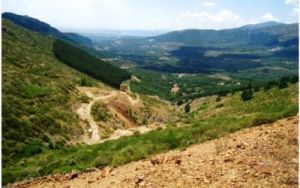Jul 25 2014
Researchers at UPM have studied the arsenic and heavy metal levels in plants from an old mine of Madrid. They identified a species that can help in phytoremediation works.

The analysis of native terrestrial plants collected in the vicinity of the old mine of Mónica de Bustarviejo (Madrid) showed high levels of cadmium, copper, lead and zinc and very high levels of arsenic concentrations, mainly found in the roots. However, some plant species had higher concentrations in the air area such as the Corrigiola telephiifolia that was identified as a possible accumulator of lead and “super accumulator” of arsenic. According to researchers from the TEMATMA research group of the School of Civil Engineering at the Universidad Politécnica de Madrid, all this can be susceptible of being used in future works of phytoremediation of polluted soils.
Over the centuries, the relevance of arsenic has been based on its poisonous nature. However, its toxicity depends on the shape or the chemical species where is found (organic or inorganic species). Furthermore, some heavy metals are considered essential or toxics depending on its concentration level. Toxic heavy metals can affect nervous system and vital organs. Certain soils are a natural source of arsenic and heavy metal due to the mining activity. These soils contribute to increase the toxic levels in surface layers of soil and are able to persist even during centuries after cessation of the activity.
The main problem of heavy metal pollution is that cannot be degraded. For this reason, there are many studies based on the usage of plants and microorganisms as methods of soils depollution. However, the toxic metal accumulation needs control and removal in order to avoid its incorporation into the food chain.
The high concentrations of arsenic found by researchers of UPM in plants from the Mónica mine led to a research to identify and quantify the arsenic species in these plants. Researchers used an analytical method that allowed them to identify up to eleven species of arsenic. The goal of this analysis was to define the content of toxic species and to understand how plants with high concentration of arsenic can survive in these environments without showing toxicity symptoms.
The results showed a high degree of arsenic biotransformation (between 70 and 89% of total arsenic in plants). A part of this biotransformation was extractable compounds in acid medium and the other part was strongly linked to structural components which are non-extractable in aqueous media. All this gives evidence of the plant capacity to transform inorganic arsenic into other less toxic chemical forms.
The majority presences of arsenate followed by arsenite (the two most toxic arsenic species) along with slight concentrations of methylated species were identified among the easily soluble species. In all cases, the contents of toxic species were relatively high and this is an environmental issue because of its possible return to the environment and its incorporation into the food chain.
García Salgado; D. García Casillas; M.A. Quijano Nieto; M.M. Bonilla Simón. Arsenic and heavy metal uptake and accumulation in native plant species from soils polluted by mining activities. Water, Air, and Soil Pollution 2012, 223, 559-572 (DOI: 10.1007/s11270-011-0882-x).
S. García-Salgado; M.A. Quijano; M.M. Bonilla. Arsenic speciation in edible alga samples by microwave-assisted extraction and high performance liquid chromatography coupled to atomic fluorescence spectrometry. Analytica Chimica Acta 2012, 714, 38-46 (DOI: 10.1016/j.aca.2011.12.001).
S. García-Salgado; M.A. Quijano. Levels of toxic arsenic species in native terrestrial plants from soils polluted by former mining activities. Environmental Science: Processes & Impacts 2014, 16, 604-612 (DOI: 10.1039/c3em00624g).